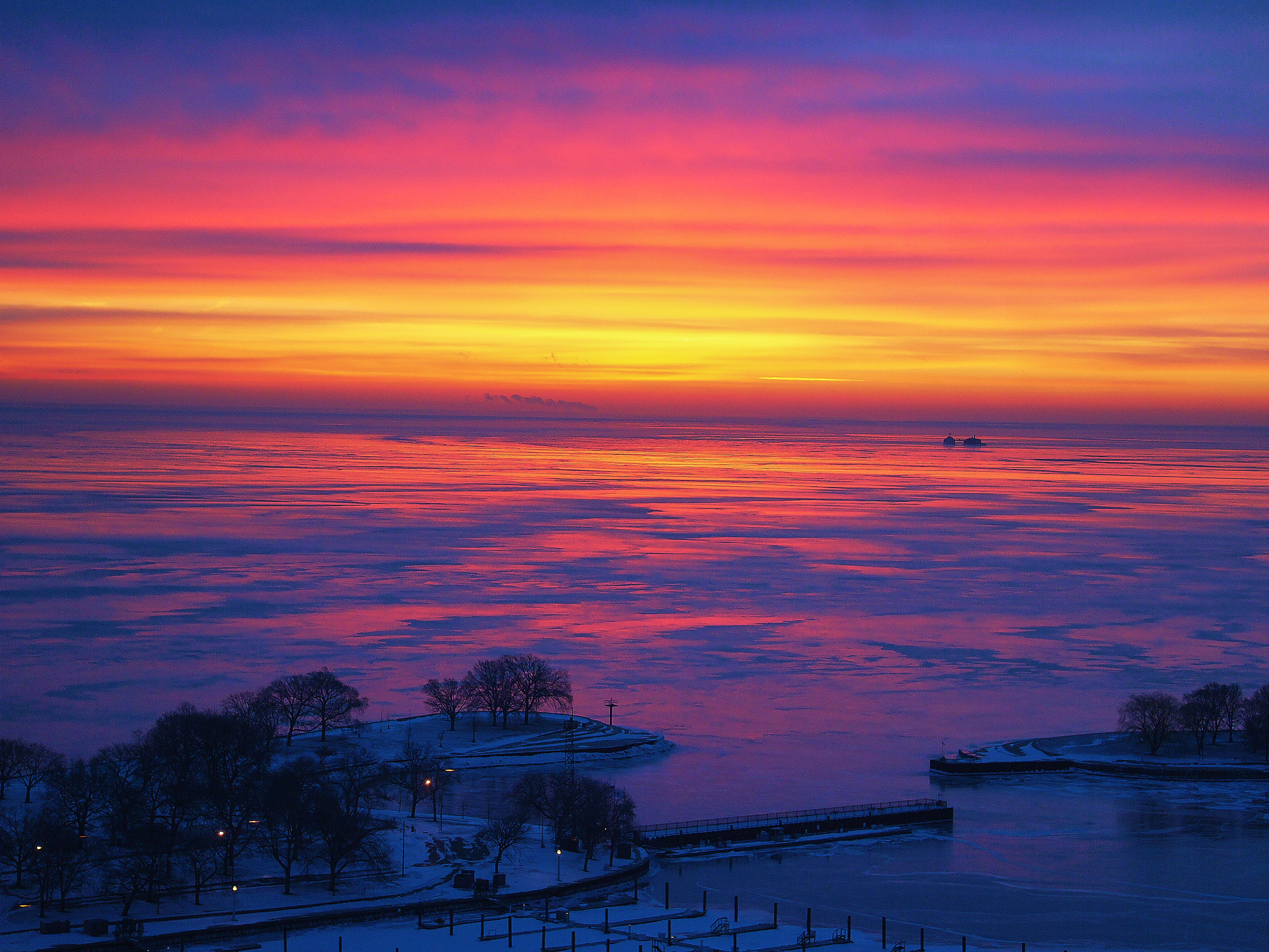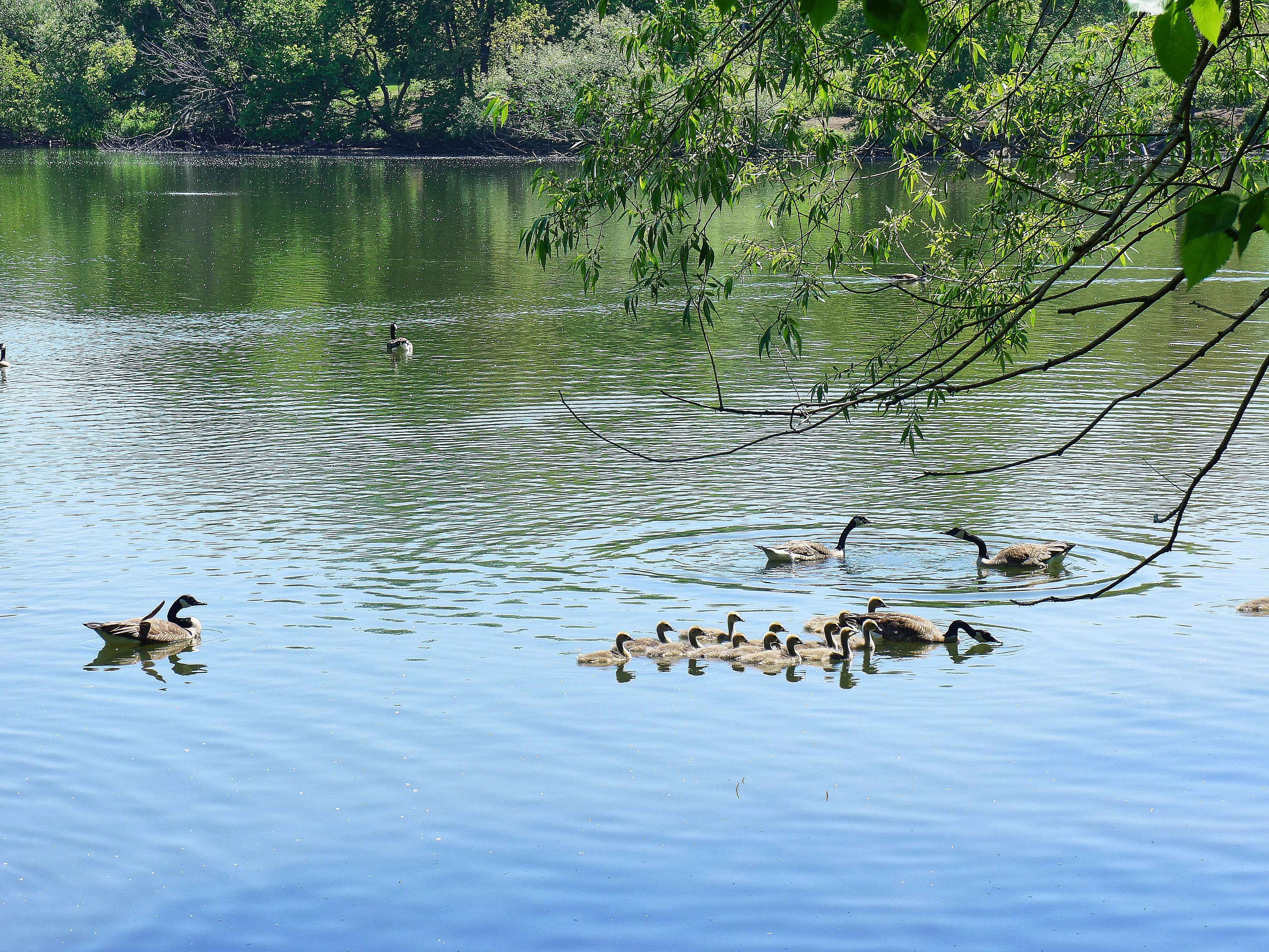Moon Over Willis Tower: This one of those right place, right time photos. Leaving an event in West Town, a longtime industrial neighborhood not far from downtown, I came upon this scene. A bright full moon illuminates the sky directly over Willis Tower, Chicago's tallest skyscraper, and it is mimicked by the bright round light of the streetlamps. This photo is special to me. (1)
(2)
(3)
(4)
(4a)
The breadth and breathtaking beauty of Chicago's night skyline is best captured from a boat ride on Lake Michigan. (5)
An overflying jet appears a speck as it soars above the downtown skyscrapers. (6)
There are boat companies that provides curated architectural tours of the Chicago River as it bisects the city's downtown. The glass-sided towers on the riverside provide amazing reflections of the city's skyline. (7)
Crown Fountain, on Michigan Avenue at the base of Millennium Park, is made up of a pair of monolithic structures, down which water cascades into a reflecting pool in which people are fond of playing on hot summer days. The columns are video screens on which photos of ordinary Chicagoans are often projected. But on this drizzly night in late April 2017, a bright orange light gave the fountain a stunning, almost supernatural glow. (8)
The Wrigley Building (with clock tower on left) and the Tribune Tower (right) have graced the opposite corners at the north end of the Michigan Avenue Bridge since Chicago's building boom of the 1920s. The John Hancock Tower, with its tall rooftop antennas, peeks up in the background. (9)
A close-up of the ornate clock face near the top of Chicago's Wrigley Building. (10)
The famed Wrigley Building takes center stage in this shot taken from a Chicago Water Taxi on the main branch of the Chicago River. (11)
The Chicago River is bathed in lights at night as it courses through downtown Chicago. (12)
This postcard view of the skyline was taken from the area outside the historic ballroom at the end of Navy Pier. The black building with antennas on top is the John Hancock Tower, Chicago's fourth tallest skyscraper. (13)
Willis Tower is Chicago's tallest building, and for many years after its completion in 1974, it was the tallest in North America. Many Chicagoans prefer to call it by its original name of Sears Tower, even though the retailing giant for which it was named moved out many years ago. (14)
The corncob-shaped Marina City apartment towers on the north side of the Chicago River gave an electric jolt to the city's skyline when they were completed in 1963. (15)
The colorful night lights of Navy Pier, seen from a tour boat on Lake Michigan, frame the downtown skyline. (16)
The ballroom at the eastern end of Navy Pier. (17)
(18)
(19)
This pretty, photogenic lighthouse is located just beyond the end of Chicago's Navy Pier. (20)
Buckingham Fountain has put on delightful water shows such as this since it was dedicated in 1927. Here it is seen from a summer boat trip on Lake Michigan. (21)
The Frank Gehry-designed Jay Pritzker Pavilion in Millennium Park, seen from a boat on Lake Michigan. (22)
Millennium Park's reflective "Cloud Gate" sculpture, better known as "The Bean," catches a sunburst, with the Frank Gehry-designed Jay Pritzker Pavilion on the right. (23)
The Jay Pritzker Pavilion in Millennium Park, seen from the Modern Wing of the Art Institute of Chicago. (24)
The free concerts and movies at the Jay Pritzker Pavilion in Chicago's Millennium Park are among the treats that make summer fun in the city. Rising above the Pavilion, designed by famed architect Frank Gehry, is the Aon Center, Chicago's 2nd tallest building behind Willis Tower. It dwarfs the Prudential Building on the left, which when it opened in 1955 was regarded as an awesome skyscraper with an observatory that drew tourists. (25)
The wreathing of the stately lion sculpture at the entrance to the Art Institute of Chicago is a longstanding Christmas season tradition. (26)
This vista, from the University Club just off Michigan Avenue, captures Chicago's most historic cultural centers: The Art Institute of Chicago in the foreground and in the background, the Museum Campus with (from left to right) the Adler Planetarium, Shedd Aquarium and the Field Museum of Natural History. The upper deck of Soldier Field, home of the NFL's Chicago Bears, is visible behind the Field. (27)
Adler Planetarium on the Museum Campus, viewed from a boat on Lake Michigan. (28)
The beautiful landscaping of Grant Park frames the skyline of the area of the downtown known as Lakeshore East. On the right is the Aon Center, Chicago's second-tallest building. The Prudential Building on the left was the tallest building in this part of the city for a number of years after it opened in 1955, but is now dwarfed by surrounding towers. (29)
The Reid Murdoch Building on the north bank of the Chicago River is downtown's sole surviving relic of the river's history as an industrial port. Now home to The Kitchen and River Roast restaurants and corporate offices, it opened in 1914 as a warehouse and headquarters for the Reid Murdoch food distribution company. It also is the sole surviving witness to Chicago's deadliest tragedy: It was forced into action as a temporary morgue in 1915 when the Eastland, an excursion boat, capsized while loading, killing 844 people. (30)
A skyline view from Burnham Harbor, just below the Museum Campus. Willis Tower, Chicago's tallest structure, is the black building center right. Below it, rising above the trees, is the Field Museum of Natural History. (31)
This Chinese pagoda graces Ping Tom Park, named for a late, longtime civic leader in Chinatown on Chicago's South Side. It is also the gateway to Chinatown for people arriving by boat down the South Branch of the Chicago River. (32)
Willis Tower is dead center in this view taken from a Chicago Water Taxi on the South Branch of the Chicago River. (33)
The mirror image reflections of the city's high-rise buildings in Lincoln Park's North Pond... (34)
... and South Pond. (35)
(36)
(37)
(38)
(39)
(40)
(41)
(42)
As illustrated by the eight previous eight photos, Lincoln Park and its beaches present outstanding views of the skyline. The park is dotted with public art installations such as the bright blue "Chevron," in the photo immediately above, installed in 2015 and better known to many people as The Windmill. (43)
(44)
(45)
The stunning skyline view is one of the biggest benefits of our apartment location day or night. The four tallest buildings in the background, about four miles to the south are (left to right, or east to west) the John Hancock Tower, Aon Center, Trump Tower and Willis Tower. (46)
The buildings on Chicago's skyline, seen from a boat on Lake Michigan, are often lighted up in bright colors for special occasions. The Aon Center is the tallest building in the foreground. The Crain Communication Building on the left is much shorter, but its diamond-shaped tilted roof gives it a distinctive place in the skyline. (47)
The tilted, diamond-shaped roof of the Crain Communication Building on Michigan Avenue gives it a distinctive place in Chicago's skyline. (48)
The top of the Wrigley Building looms over the City of Chicago engraving at the top of the bridge house at the southwest corner of the Michigan Avenue Bridge over the Chicago River. (49)
(50)
Sunbursts dazzle the Chicago skyline and throw broad sunglades across Lake Michigan in these views from a boat. (51)
Temple Sholom is located in Chicago's Lakeview neighborhood. Its Reform Jewish congregation was founded in 1867, which mean it already was 61 years old when its current home was completed in 1928 (the congregation celebrated its 150th anniversary in 2017). I live just a block away, and I especially like this photo because the temple is surrounded by apartment buildings constructed about the same time. So in this angle, you are seeing this corner of Chicago almost exactly as it looked more than 80 years ago. (52)
The Chicago Board of Trade Building houses the exchange for agriculture commodities. This Art Deco classic was completed in 1930 and was the tallest building in Chicago for the next 35 years. It is topped by a statue of Ceres, the Roman goddess of agriculture and grain, from which the word "cereal" is derived. (53)
(54)
Two views of the John Hancock Tower on cloudless days. (55)
The Merchandise Mart has anchored the west end of the Chicago River's main branch since it opened in 1930. With more than 4 million square feet of floor space, it was for many years the world's most spacious building and still ranks as one of the biggest. While it still maintains the product showrooms that were its specialty for most of its history, the Mart in recent years has become home to many companies in the city's growing tech sector, as well as 1871, the city's leading center for technological and entrepreneurial innovation. FamilyFarmed, the non-profit Good Food advocacy organization for which I work, runs its Good Food Accelerator entrepreneurial program out of 1871. (56)
Beautiful stained glass domes make the Chicago Cultural Center on Michigan Avenue an attraction for art lovers and tourists. The one above is the world's largest stained glass dome designed by the famed Louis Comfort Tiffany. (57)
A smaller but stunning stained glass dome is found in the Chicago Cultural Center's Grand Army of the Republic rotunda, originally built in 1897 as a meeting hall and memorial to those who served in the Union Army during the Civil War. From that year until 1977, it served as Chicago's central public library. (58)
The smokestacks at sunrise make the Northern Indiana steel mills at the southern end of Lake Michigan look much closer than the 30 miles that they are from our apartment in Chicago's Lakeview neighborhood. Navy Pier is in the foreground. (59)
The glass-sided Roosevelt University tower near the south end of downtown Chicago reflects the passing clouds. (60)









